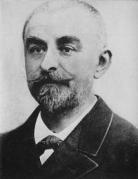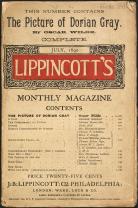Joris-Karl Huysmans and À Rebours
Created by Sean Murphy on Tue, 04/27/2021 - 18:25
Timeline covering French Decadence author Joris-Karl Huysmans and his novel A Rebours, which heavily inspired The Picture of Dorian Gray.
Timeline
Chronological table
| Date | Event | Created by | Associated Places | |
|---|---|---|---|---|
| The start of the month Feb 1848 |
Birth of Joris-Karl HuysmansJoris Karl Huysmans (1848-1907) is born in Paris to a French mother and Dutch father. In addition to serving many decades in the Ministry of the Interior, Huysman was a prolific novelist. His early work was associated with the naturalist movement, but the subject matter and style would shift into decadence. Thematically, Huysmans work was highly autobiographical, involving the protracted spiritual struggle of a central protagonist. His most well-known work, A Rebours, revolves around a single character's descent into total decadence. Escapism is a central component of these works, as his characters reject the material world in pursuit of meaning through debauchery. This comes to a head in L'Oblat, where Huysmans rejects escapism through the protagonist, recognizing it as futile. Huysmans was also an art critic and an early advocate for the French Impressionist movement. |
Sean Murphy | ||
| May 1884 |
A Rebours is publishedHuysmans' most famous work, A Rebours (Against the Grain) depicts Jean des Esseintes, the scion of a noble Parisian family, rejecting society and retreating into a period of artistic and aesthetic rumination. Featuring the protagonist as the only character, the book is driven not by traditional plot progression but rather the experience of Esseintes as he recounts his thoughts on art, literature, and the world around him. Through its focus on hedonistic pursuits, and themes of artifice being preferable to the natural, the book became essential tenet of the French Decadent movement, as well as an inspiration for the aesthetic movement down the line. |
Sean Murphy | ||
| Jul 1890 |
The Picture of Dorian Gray is publishedWilde's novel was undoubtedly inspired by Huysmans A Rebours. The "poisonous french novel" which, in the novel, helps Dorian down the path of corruption is believed to be a direct reference to the book. The descriptions Wilde gives, of a single character descending further and further into debauchery after withdrawing from society, is a spot-on description of the books plot. Wilde was confirmed to have read and loved A Rebours, saying of it "This last book of Huysmans is one of the best I have ever seen." In addition to explicit references, the themes of Dorian Gray have much to do with Huysmans' work. The aesthetic principles of withdrawal from society, indulgence in hedonism, and emphasis on colorful prose and vivid style over Victorian restraint owes much to the French Decadent movement that Huysmans was at the center of. Wilde's play Salome was also most likely inspired by A Rebours, in which paintings on the theme of Salome are prominently featured. |
Sean Murphy |



